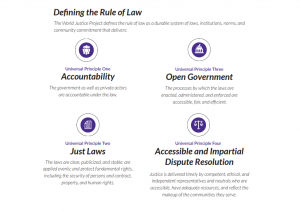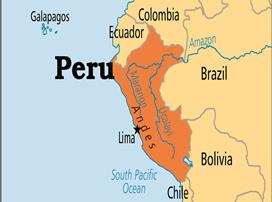THE RULE OF LAW VS THE RULE BY LAW
“The “Rule of Law” is what we fought for; the “Rule by Law” is an instrument of colonial rule. In the face of a pandemic, it’s important to reflect on how the tension between the two defines the quality of justice.”
———- Chief Justice N.V. Ramana
THE CONTEXT: On June 30th, 2021, Chief Justice N.V. Ramana delivered the 17th Justice P.D. Desai Memorial Lecture on the “Rule of Law”. According to CJI, regular participation in polls was not a guarantee against the tyranny of the elected. In his speech, he underscored the pressure of social media on institutions. Identifying Covid-19 as “an unprecedented crisis”, CJI urged the governments to evaluate how they used the rule of law or failed to ensure protection to, and, the welfare of all of our people. This article provides insights into the lecture on the Rule of Law vs. the Rule by Law.
IMPORTANT EXCERPTS OF THE LECTURE
JOURNEY FROM RULE BY LAW TO RULE OF LAW:
- Our struggle for independence marked our journey towards the establishment of a state defined by the “Rule of Law”.
- There was a need to give a guarantee for the laws to be framed with a human face for the benefit of the masses. A framework was needed to ensure this. The framework that forms the binding link between law and justice in this country is what “We the people” gave to ourselves in the form of the Constitution.
CONSTITUTION AND RULE OF LAW:
- The framers envisaged the Constitution which not only took care of the prevailing conditions but would also continue and be relevant for all times to come. Therefore Constitution is conceived as a living document whose contents evolve over the years, as the Courts deal with new situations and question and interpret the Constitution in the light of the same.
- The Constitution embodies within itself the concept of Rule of Law and the same can be witnessed from our Preamble, the Fundamental Rights, the Directive Principles of State Policy, the Separation of Powers, etc.
- By situating the concept of Rule of Law at the confluence of three important values – human dignity, democracy, and justice, our founding fathers showed the path for the rest of the world too.
ADVICE TO JUDICIARY:
- For the judiciary to apply checks on governmental power and action, it has to have complete freedom. The judiciary cannot be controlled, directly or indirectly, by the legislature or the executive, or else the Rule of Law would become illusory.
- Judges should not be swayed by the emotional pitch of public opinion, which is getting amplified through social media platforms. Judges have to be mindful of the fact that the noise thus amplified is not necessarily reflective of what is right and what the majority believes in.
- Social media is incapable of distinguishing between right and wrong, good and bad, and the real and fake. Therefore, media trials cannot be a guiding factor in deciding cases. It is therefore extremely vital to function independently and withstand all external aids and pressures.
- The ultimate responsibility of a judge is to uphold the Constitution and the laws. Reason, reasonableness, and protection of human dignity are the values that will serve us well.
THE ROLE OF LAWYERS:
- The “Rule of Law” demands expertise, experience, and commitment. Lawyers should perform their duties with integrity and diligence. We need social virtue rather than economically self-interested behavior.
- Historically, lawyers have a rich tradition of social activism demonstrated by the number of lawyers who participated in the Indian freedom struggle.
- We need now to rebuild and recreate a tradition of civic professionalism. We need a professional ideology about social responsibility.
- Both young and senior counsels should extend a helping hand to those in need of justice. Extending ease of access to justice is no less a social justice.
THE ROLE OF SOCIETY:
- To advance the “Rule of Law” we primarily need to create a society where “Rule of Law” is respected and cherished.
- Only when the citizens believe that they have fair and equal access to justice, can we have sustainable, just, inclusive, and peaceful societies.
- Citizens can strengthen the “Rule of Law” by being knowledgeable about it and by applying it to their daily conduct and pushing for justice when needed.
4 CORE PRINCIPLES OF RULE OF LAW
PRINCIPLE: ‘LAWS MUST BE CLEAR AND ACCESSIBLE’
DETAILS: When laws are expected to be obeyed, the people at least ought to know what the laws are. Law should be worded in simple, unambiguous language.
ANALYSIS/PRESENT STATUS: In India, we are constantly striving to make legislations and judgments accessible to the general public by translating them into various Indian languages.
PRINCIPLE: “EQUALITY BEFORE THE LAW”
DETAILS: An important aspect of “equality before the law” is having equal “access to justice”. Access to justice forms the bedrock of the “Rule of Law”.
ANALYSIS/PRESENT STATUS: This guarantee of equal justice will be rendered meaningless if the vulnerable sections are unable to enjoy their rights because of their poverty illiteracy or any other kind of weakness. There is a need for legal empowerment of women. It not only enables them to advocate for their rights and needs in society but also increases their visibility in the legal reform process.
PRINCIPLE: “RIGHT TO PARTICIPATE IN THE CREATION AND REFINEMENT OF LAWS”
DETAILS: The very essence of a democracy is that its citizenry has a role to play, whether directly or indirectly, in the laws that govern them.
ANALYSIS/PRESENT STATUS: In the seventeen national general elections held so far, the people have changed the ruling party or combination of parties eight times, which accounts for nearly 50 percent of the number of general elections. Despite large-scale inequalities, illiteracy, backwardness, poverty, and alleged ignorance, the people of independent India have proved themselves to be intelligent and up to the task. The masses have performed their duties reasonably well.
PRINCIPLE: “STRONG INDEPENDENT JUDICIARY”
DETAILS: The judiciary is the primary organ that is tasked with ensuring that the laws which are enacted are in line with the Constitution. Judicial review is one of the main functions of the judiciary.
ANALYSIS/PRESENT STATUS: The Supreme Court has held this function to be a part of the basic structure of the Constitution, which means that the Parliament cannot curtail the same. But the responsibility of safeguarding constitutionalism lies not just on the Courts. All the three organs of the State, i.e., the executive, legislature, and the judiciary, are equal repositories of Constitutional trust. The role of the judiciary and scope of judicial action is limited, as it only pertains to facts placed before it. This limitation calls for other organs to assume responsibilities of upholding Constitutional values and ensuring justice in the first place, with the judiciary acting as an important check.
THE RULE OF LAW BY DICEY
- A detailed analysis of the concept of Rule of Law was done by Professor A.V. Dicey who in his book “Introduction to the Study of the Law of the Constitution” published in the year 1885 tried developing the concept of Rule of Law.
- Dicey’s theory of Rule of Law consists of three basic principles:
- The supremacy of law
- Equality before law
- The predominance of Legal Spirit
THE EVOLUTION OF THE RULE OF LAW
- The origins of the Rule of Law theory can be traced back to the Ancient Romans during the formation of the first republic.
- Plato has written that if rule of law is under the supervision of any law then it doesn’t have any value and the concept of state will get collapsed. Aristotle has written that law should be the final sovereign of the state.
- It has since been championed by several thinkers in Europe such as Hobbs, Locke, and Rousseau through the social contract theory.
DIFFERENCE BETWEEN RULE OF LAW AND RULE BY LAW
RULE OF LAW
DEFINITION: The term “rule of law” comes from the French phrase “la Principe de legality,” which translates to “government based on legal principles.” It is based on the Latin phrase “Lex is Rex,” which translates to “Law is King.”
ORIGIN: The Rule of Law was first originated by Sir Edward Coke, the Chief Justice in England at the time of King James I. Coke was the first person to criticize the maxims of Divine Concept. He strongly believed that the King should also be under the Rule of Law. According to him, “Rule of Law” means the absence of arbitrary power on the part of the Government.
THE CONCEPT: The state should act as per the “Rule of Law” which is the foundation of any constitution.
RULE BY LAW
DEFINITION: It is based on the Latin term ‘Rex is Lex’ which means ‘King is Law’.
ORIGIN: In his battle against the Church and common law judges, King James I of England triumphed, twisting the phrase ‘Lex is Rex’ to ‘Rex is Lex.’
THE CONCEPT: The state acts as per what it this as lawful rather than what the “Rule of Law” says like invoking section 144 without its necessity.
RULE OF LAW AND INDIAN CONSTITUTION
- In India, the concept of Rule of Law can be traced back to Upanishads. Its traces can also be found in the epics like Mahabharata and Ramayana, Ten Commandments, Dharma Chakra, and other seminal documents.
- The Preamble to the Indian Constitution mentions Justice, Liberty, and Equality.
- Articles 13, 14, and 21 of the Indian Constitution promote equality although there are exceptions as well.
- Some Exceptions:
- Articles 15 and 16, Article 105 and Article 194.
- Criminal immunity to President and Governor as mentioned in Article 361.
- Diplomatic Immunity as per the Vienna Convention.
JUDICIAL PRONOUNCEMENTS ON RULE OF LAW
The judicial decisions have played an indispensable role to counter any arbitrariness on part of the state.
- In K. Kraipak V. Union of India the Apex Court held that ours being a welfare State, it is regulated and controlled by the Rule of Law.
- In Maneka Gandhi v. Union of India, the court ensured that the exercise of power in an arbitrary manner by the government would not infringe the rights of the people.
- The Apex Court in Indira Nehru Gandhi Vs. Raj Narain (1975) held that the Rule of Law embodied in Article 14 of the Constitution is the “basic feature” of the Indian Constitution and hence it cannot be destroyed even by an amendment of the Constitution under Article 368 of the Constitution.
- In L Chandra Kumar v Union of India, the court declared the independence of the judiciary to be a part of the basic structure and further the court struck down the amendment to article 323A of the constitution.
- The Habeas Corpus Case (1976) held that article 21 is the sole repository of Rule of law in India.
The International Congress of Jurists declared that the rule of law “is a dynamic concept which must be employed to safeguard and advance the civil and political rights of an individual in a free society.”
ANALYSIS: PRESENT STATUS OF RULE OF LAW IN INDIA
In India, the Rule of Law is not followed in stricto sensu (“In the strict sense.”). There are several instances:
- Several guidelines have been laid down by the court to curb the practice of honor killing but still, there have been numerous instances of honor killing reported. The decision on honor killing is taken by an extra-constitutional body by the nomenclature of Khap Panchayat which engages in feudalistic activities has no compunction to commit such crimes which are offenses under the Indian Penal Code, 1860. No heed is paid to the basic human right of “Right to life and liberty”.
- The Sabarimala case verdict throws light upon the discretion of men in abiding by the directions given by the Supreme Court only to the point if they are analogous to the belief they hold. After the verdict massive protests were carried out, there were also occurrences of violence against women who tried to enter the temple. The women were denied their constitutional right to worship and the principles of equality were violated even after the practice was declared unconstitutional by the Apex Court.
- Another evil practice pertinent in society is that of mob lynching. Supreme Court described it as horrendous acts of mobocracy and stated that “the law is the mightiest sovereign in a civilized society”.
In fact, the present debate has started due to an increase in the incidences of RULE BY LAW like
- Internet shutdown in J&K for over one year
- The arbitrary application of laws against media and journalists
- The arbitrary application of UAPA, sedition law, and NSA against protesters, dissenters, activists, etc.
- Gagging criticisms on the mishandling of covid second wave
Such developments give a feeling of an authoritarian state and not of a democratic state. The CJI in his lecture has also highlighted how the people have largely plaid their role through 17 general elections and have rejected the governments if they have failed to withstand the rule of law. No government is permanent. Hence, it is the duty cast upon the three organs to play their role in upholding the rule of law.
THE CONCLUSION: The work of ensuring complete justice can never be said to be completed. The mandate of our Constitution is to work tirelessly to surpass our expectations, to make India a country wherein rights are cherished, and which sets an example for other countries to follow.
“Desamamte Matti Kadoi, Desamamte ManushulOi”(“A nation is not merely a territory. A nation is essentially its people. Only when its people progress, the Nation progresses”)
———– Maha Kavi Gurajada Appa Rao,
WORLD JUSTICE PROJECT’S RULE OF LAW INDEX
- The World Justice Project (WJP) is an independent, multidisciplinary organization working to create knowledge, build awareness, and stimulate action to advance the rule of law worldwide. Effective rule of law reduces corruption, combats poverty and disease, and protects people from injustices large and small. It is the foundation for communities of justice, opportunity, and peace—underpinning development, accountable government, and respect for fundamental rights.

- The scores and rankings of the WJP Rule of Law Index are organized around eight primary factors: Constraints on Government Powers, Absence of Corruption, Open Government, Fundamental Rights, Order and Security, Regulatory Enforcement, Civil Justice, and Criminal Justice.
- The WJP Rule of Law Index 2020 shows that more countries declined than improved in overall rule of law performance for the third year in a row, continuing a negative slide toward weakening and stagnating rule of law around the world.
- Denmark, Norway, and Finland topped the WJP Rule of Law Index rankings in 2020. Venezuela, RB, Cambodia, and the Democratic Republic of Congo had the lowest overall rule of law scores.
- India is ranked 69th among 128 countries.

